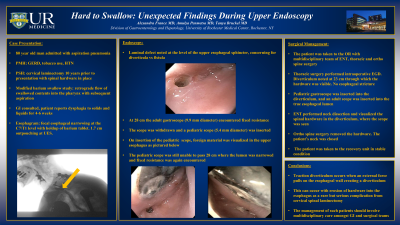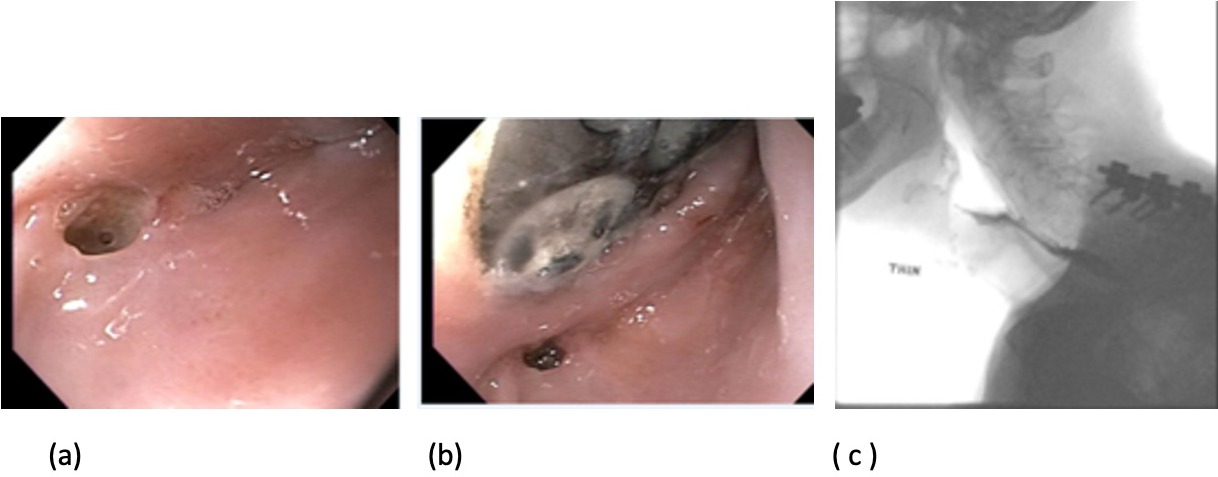Tuesday Poster Session
Category: Esophagus
P3289 - Unexpected Finding of Spinal Hardware Within the Esophageal Lumen Causing Dysphagia
Tuesday, October 24, 2023
10:30 AM - 4:00 PM PT
Location: Exhibit Hall


Alexandra France, MD
University of Rochester Medical Center
Rochester, NY
Presenting Author(s)
Alexandra France, MD, Amulya Penmetsa, MD, Tanya Bruckel, MD
University of Rochester Medical Center, Rochester, NY
Introduction: Cervical spinal laminectomy is a commonly performed spinal surgery, with potential for
intraoperative, postoperative, or long-term complications. Erosion of spinal hardware into the
esophageal lumen is uncommon, especially in the long-term post-operative period, and can
result in pain, dysphagia, and aspiration pneumonia. We present a case of an elderly man with
erosion of anterior spinal hardware into his esophagus, more than 10 years after spinal surgery.
Case Description/Methods: An 80-year-old man was admitted with aspiration pneumonia and several weeks of dysphagia.
His past medical history included GERD, hypertension, tobacco use and prior cervical
laminectomy over 10 years ago, with spinal hardware in place. Esophagogastroduodenoscopy
(EGD) revealed a mucosal defect (a) at the level of the upper esophageal sphincter (UES),
consistent with an esophageal diverticula. The endoscope encountered fixed resistance and
could not be advanced beyond 28 cm from the incisors. Upon withdrawal, metal hardware (b)
was seen within the esophageal lumen at the level of the UES, adjacent to the previously noted
mucosal defect. Pharyngogram (c) confirmed presence of traction diverticulum at the level of
spinal hardware. After multidisciplinary discussion with thoracic surgery, otolaryngology, and
spine surgery, the patient was taken to the operating room for removal of the hardware with
primary closure of the esophageal defect. He recovered well and was discharged from the
hospital 13 days later. He was kept strictly NPO for two weeks, and on clinic follow-up, was
tolerating oral diet with resolution of dysphagia.
Discussion: Esophageal perforation related to anterior spinal surgical hardware is a rare complication, but
can lead to morbidity and mortality. The literature reports an average time to presentation of 2
years, though there are case reports that discuss this occurrence up to 9 years post-operatively.
Delayed esophageal perforation from hardware is attributed to tissue erosion via chronic
pressure on the esophageal wall. This results in ischemia and can lead to formation of a
diverticulum, which compromises the esophageal wall integrity. Hardware migration over time
also plays a role in many cases.
Patients who present with pain, hoarseness, dysphagia and aspiration should be evaluated.
Given its rarity, a high index of suspicion is required in order to make the diagnosis in a timely
manner. Surgical revision with hardware removal and closure of the esophageal defect are the
standard of care.

Disclosures:
Alexandra France, MD, Amulya Penmetsa, MD, Tanya Bruckel, MD. P3289 - Unexpected Finding of Spinal Hardware Within the Esophageal Lumen Causing Dysphagia, ACG 2023 Annual Scientific Meeting Abstracts. Vancouver, BC, Canada: American College of Gastroenterology.
University of Rochester Medical Center, Rochester, NY
Introduction: Cervical spinal laminectomy is a commonly performed spinal surgery, with potential for
intraoperative, postoperative, or long-term complications. Erosion of spinal hardware into the
esophageal lumen is uncommon, especially in the long-term post-operative period, and can
result in pain, dysphagia, and aspiration pneumonia. We present a case of an elderly man with
erosion of anterior spinal hardware into his esophagus, more than 10 years after spinal surgery.
Case Description/Methods: An 80-year-old man was admitted with aspiration pneumonia and several weeks of dysphagia.
His past medical history included GERD, hypertension, tobacco use and prior cervical
laminectomy over 10 years ago, with spinal hardware in place. Esophagogastroduodenoscopy
(EGD) revealed a mucosal defect (a) at the level of the upper esophageal sphincter (UES),
consistent with an esophageal diverticula. The endoscope encountered fixed resistance and
could not be advanced beyond 28 cm from the incisors. Upon withdrawal, metal hardware (b)
was seen within the esophageal lumen at the level of the UES, adjacent to the previously noted
mucosal defect. Pharyngogram (c) confirmed presence of traction diverticulum at the level of
spinal hardware. After multidisciplinary discussion with thoracic surgery, otolaryngology, and
spine surgery, the patient was taken to the operating room for removal of the hardware with
primary closure of the esophageal defect. He recovered well and was discharged from the
hospital 13 days later. He was kept strictly NPO for two weeks, and on clinic follow-up, was
tolerating oral diet with resolution of dysphagia.
Discussion: Esophageal perforation related to anterior spinal surgical hardware is a rare complication, but
can lead to morbidity and mortality. The literature reports an average time to presentation of 2
years, though there are case reports that discuss this occurrence up to 9 years post-operatively.
Delayed esophageal perforation from hardware is attributed to tissue erosion via chronic
pressure on the esophageal wall. This results in ischemia and can lead to formation of a
diverticulum, which compromises the esophageal wall integrity. Hardware migration over time
also plays a role in many cases.
Patients who present with pain, hoarseness, dysphagia and aspiration should be evaluated.
Given its rarity, a high index of suspicion is required in order to make the diagnosis in a timely
manner. Surgical revision with hardware removal and closure of the esophageal defect are the
standard of care.

Figure: a) Diverticula in the upper esophagus b) Metal hardware in the esophageal lumen c) Pharyngogram showing accumulation of barium at the level of T1, suggesting likely traction diverticulum with contrast escape around spinal hardware.
Disclosures:
Alexandra France indicated no relevant financial relationships.
Amulya Penmetsa indicated no relevant financial relationships.
Tanya Bruckel indicated no relevant financial relationships.
Alexandra France, MD, Amulya Penmetsa, MD, Tanya Bruckel, MD. P3289 - Unexpected Finding of Spinal Hardware Within the Esophageal Lumen Causing Dysphagia, ACG 2023 Annual Scientific Meeting Abstracts. Vancouver, BC, Canada: American College of Gastroenterology.
